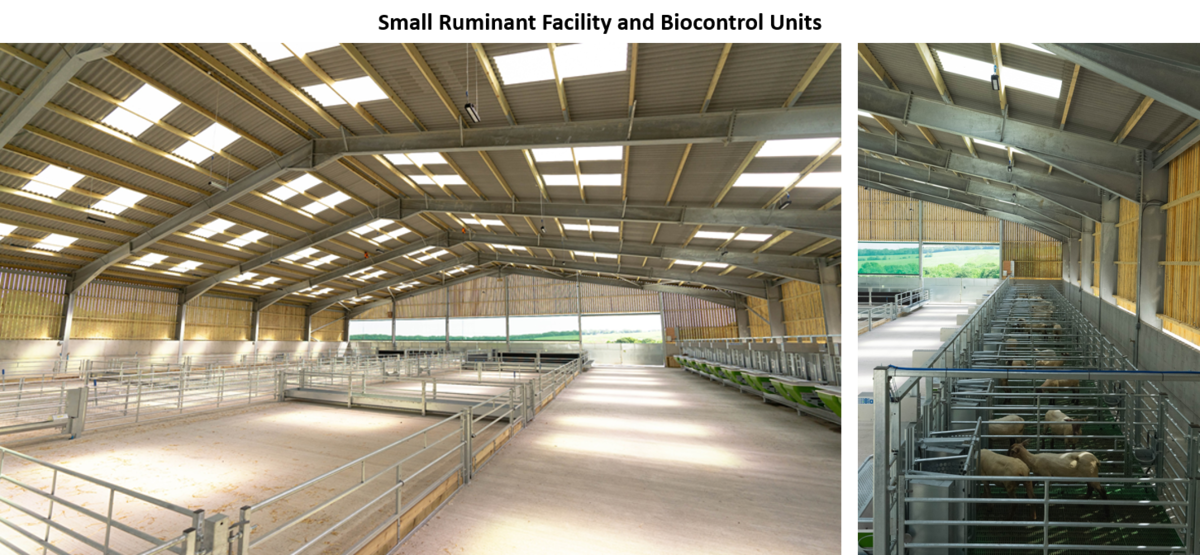Using Our Facilities and Opportunities for Co-Development
The unique facility is located in the South West of the UK and offers the research community access to a range of
in-situ state-of-the-art instrumentation installed over three hydrologically isolated farming systems or farmlets.
The platform also has an indoor cattle system that is similarly instrumented.
Each outdoor farmlet consists of five component sub-catchments comprising just over 20 ha in total per farmlet.
They are currently managed as beef cattle, sheep and arable enterprises with a high degree of control over inputs.
The key concept of the Farm Platform is to explore different ways of managing sustainable and resilient grazing livestock production alongside a wide range of agro-ecosystem attributes at farm scale. Opportunities also exist for investigating net zero strategies.
The facility attracts researchers from different communities and disciplines to promote new ideas or tackle old challenges in novel ways to better address key issues in sustainable and resilient agriculture.
All core input and output data collected from across the platform is freely available to all national and international research users and collaborators via our Data Portal.
We have dedicated laboratories to handle soil, herbage, air and water samples and have a wide range of analytical techniques available in our Analytical Laboratories.
In addition, we have the Small Ruminant Facility (SRF; Robert Orr building) which is used to not only house the Farm Platform sheep during the winter period but which also contains 24 automated biocontrol units. These units allow the recording of individual feed intake using automatically weighed feed hoppers and which are available for studies concerning animal health, welfare and performance. Some pens within the facility have also been specifically designed to accommodate goat housing.

We welcome opportunities for co-development of projects on the platform. Project proposals can be of any size and through any funding body.
If you are interested in proposing or conducting a research project using the Farm Platform facilities, please contact the North Wyke Farm Platform team (nw.farmplatform@rothamsted.ac.uk) for initial discussions, where we will align you with the contacts and expertise to facilitate your proposal or project. This is the first step, where the second step (following initial consultation) is to complete the farm platform access form in the Downloads section and submit for approval.
Our facilities are part-funded by CIEL (https://www.cielivestock.co.uk/). As such, if you are considering applying for funding to conduct an NWFP or SRF experiment, then please contact us so that we can ensure a small charge (typically 2%) is captured in the funding application reflecting CIEL's investment.
Finally, if you decide to use our data in any publications or have used the NWFP facilities, then please:
1. Cite one or both of the following 2 papers:
R.J. Orr, P.J. Murray, C.J. Eyles, M.S.A. Blackwell, L.M. Cardenas, A.L. Collins, J.A.J. Dungait, K.W.T. Goulding, B.A. Griffith, S.J. Gurr, P. Harris, J.M.B. Hawkins, T.H. Misselbrook, C. Rawlings, A. Shepherd, H. Sint, T. Takahashi, K.N. Tozer, A.P. Whitmore, L. Wu and M.R.F. Lee. (2016). The North Wyke Farm Platform: effect of temperate grassland farming systems on soil moisture contents, runoff and associated water quality dynamics. European Journal of Soil Science, 67, 374-385.
T. Takahashi, P. Harris, M. S. A. Blackwell, L. M. Cardenas, A. L. Collins, J. A. J. Dungait, J. M. B. Hawkins, T. H. Misselbrook, G. A. McAuliffe, J. N. McFadzean, P. J. Murray, R. J. Orr, M. J. Rivero, L. Wu, M. R. F. Lee, 2018. Roles of instrumented farm-scale trials in trade-off assessments of pasture-based ruminant production systems. Animal, 1766-1776.
2. Add that data were downloaded from the Farm Platform Data Portal, with the URL:
http://resources.rothamsted.ac.uk/farmplatform
3. Add the following paragraphs to your acknowledgments section:
The North Wyke Farm Platform is a UK National Capability supported by the Biotechnology and Biological Sciences Research Council (BBS/E/C/000J0100).
We acknowledge the interests of the Ecological Continuity Trust (ECT), whose national network of LTEs includes the experiment on which this research was conducted
